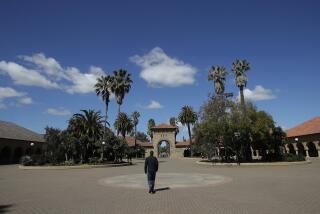California bill would make it cheaper for some students in Mexico to attend college in the U.S.

Abril Hernandez, a student at Southwestern Community College, sat in her car waiting in a seemingly never-ending line to cross the San Diego-Mexico border. It had already been a two-hour wait, but she knew the drill by now.
âYou spend most of your time in line,â Hernandez, 33, said in Spanish. âWhen you finally get home you only have time for sleep.â
Hernandez, who was born in the U.S., has lived on both sides of the border while studying for an engineering degree at Southwestern College. Before her child was born, she would spend weekdays living with her father in San Diego so that she could attend class and avoid the high cost of non-resident tuition. On weekends, she would cross over to Tijuana to go home to her mother.
âIt was uncomfortable having to go back and forth and not have a stable home,â she said.
Hernandez now stays in San Diego full time. But for several years before her baby was born, she was one of approximately 7,000 students from kindergarten through college â among 100,000 people total â who cross the San Ysidro Port of Entry each day. Binational students living near the border, many of whom are U.S.-born children in low-income households, attend school in California but may live in Mexico because itâs more affordable.
To serve these binational students, Assemblymember David Alvarez (D-San Diego) introduced Assembly Bill 91 to make it easier for students who live in Mexico to attend college in California. The bill would create a five-year pilot program allowing low-income students who live in Mexico within 45 miles of the California border to pay in-state tuition to attend one of seven campuses in the San Diego and Imperial Valley Counties Community College Assn.
âItâs a well-integrated economy that weâre proud of in this region,â Alvarez said in an interview. âWe hope that by educating the future workforce â which happens to live on the Mexican side â we can continue to grow as a region and create more economic opportunities.â
Under his bill, each participating college would host up to 200 binational students during the pilot phase. Students would have to be U.S. citizens or Mexican citizens with a visa to participate in the program.
Qualifying students would pay in-state tuition, which is $46 per unit compared with the average $300 non-resident fee.
âWe believe so strongly in our region and believe itâs important to treat binational students as residents with in-state tuition as opposed to foreign students,â Alvarez said.
Legislative officials have not yet calculated how much the proposal would cost the state. It comes as California faces an estimated $22.5-billion budget deficit and huge enrollment drops at many community colleges.
Enrollment at community colleges across California severely declined between fall 2019 and fall 2021, dropping to its lowest level in 30 years. At Southwestern College â one of the San Diego campuses that could participate in the pilot program â enrollment decreased by 20.3%. Enrollment rates throughout Imperial Valley dropped by 25% but have slowed in decline since 2021, said Olga Rodriguez, the director of the Public Policy Institute of Californiaâs Higher Education Center.
Community college enrollment is at its lowest level in 30 years as educators scramble to meet the needs of a new generation of students who may be questioning the value of higher education.
In previous recessions, colleges would recruit non-resident students as a strategy to produce more revenue, but âitâs a wiser economic decision for regional economies to identify and train their communities,â Rodriguez said.
Assemblymember Devon Mathis (R-Visalia) said he supports developing a state workforce through legal immigration, but parts of the bill concern him.
âWe need to ensure this bill wonât pull funds away from the rest of the community college system, and do more to encourage students to stay in California and build their careers here after graduation,â Mathis said in an email statement. âWith a $22 billion deficit, we should look to public-private partnerships with businesses and the trades rather than creating a new taxpayer-funded program.â
Alvarez said that colleges are focused on bringing back students lost during the pandemic and that this program would not âtake away any seatsâ from Californians. According to the bill text, non-resident students exempt through AB 91 would be reported as resident full-time equivalent students, whom the college can claim for government funds based on enrollment.
AB 91 is based on the residency agreement Californiaâs Lake Tahoe Community College District has with students living near the Nevada border, Alvarez said. The California Nevada Interstate Attendance Agreementallows some Nevada residents to pay in-state tuition at some California colleges.
âOne of the things that Tahoe does uniquely is that it operates as a region,â said Laura Metune, the college districtâs senior director of government relations and grant development. âOur role is ensuring that communities across the basin have what they need in terms of workforce development, and being able to serve students from both sides allows us to be fully aligned with community needs.â
The college district began asking for special authorization to serve students living on the Nevada side of the Tahoe Basin about a decade ago. âIt took us a couple times going through the Legislature, but ultimately they supported it,â Metune said.
About a year ago, the law was expanded to serve more Nevada students by including those in cities just beyond the Tahoe basin. Nearly 30 students participate in the program each year, with the agreement capping Nevada student enrollment at 200. The legislation also allows the college district to claim government funds for the enrollment of these students.
âOur community clearly includes students on the Nevada side of the Tahoe Basin. And it seems the San Diego and Imperial colleges similarly think that students served under this new bill would be consistent with the community college mission to serve the local community,â Metune said.
Additionally, the legislation aims to expand already existing programs between U.S. and Mexican colleges, such as the partnership between Southwestern College and the University of Baja California.
âThis is a testament to the quality of education that our community colleges are providing,â Alvarez said. âThey can serve students from other places, especially when it makes sense geographically as it does for our unique region down here in San Diego.
âPeople think that you have to go far from San Diego to get to Mexico. No, we are there.â
AB 91 may be heard in committee this month.
More to Read
Sign up for Essential California
The most important California stories and recommendations in your inbox every morning.
You may occasionally receive promotional content from the Los Angeles Times.












